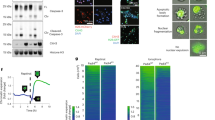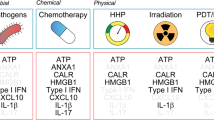Abstract
Human carcinoembryonic antigen (CEA) is a cell surface adhesion molecule member of the Immunoglobulin Superfamily (IgSF). Aberrant upregulation of CEA is a common feature found in a wide variety of human cancers such as colon, breast and lung. Previous in vitro and in vivo results have demonstrated that CEA can have tumorigenic effects including the inhibition of cell differentiation and anoikis, a specific type of apoptosis triggered by the absence of extracellular matrix–cell contacts. In the present work, we investigate the involvement of the caspase cascade in CEA-mediated inhibition of anoikis and the structural requirements for this signal. Expression of CEA and/or a chimeric protein consisting of the NCAM extracellular domain attached to the CEA-GPI anchor correlates with an early inactivation of caspase-9 and activation of the PI3-K/Akt survival pathway, and at later times, inactivation of caspase-8. The CEA-mediated caspase inactivation as well as activation of Akt was not observed by expression of a CEA molecule incapable of self-binding (ΔNCEA). These results suggest that the intrinsic caspase pathway is involved in the inhibitory effects of anoikis by CEA and this signal is dependent on the presence of self-adhesive extracellular domains and a CEA-GPI anchor.
This is a preview of subscription content, access via your institution
Access options
Subscribe to this journal
Receive 50 print issues and online access
$259.00 per year
only $5.18 per issue
Buy this article
- Purchase on Springer Link
- Instant access to full article PDF
Prices may be subject to local taxes which are calculated during checkout





Similar content being viewed by others
References
Benchimol S, Fuks A, Jothy S, Beauchemin N, Shirota K, Stanners CP . (1989). Carcinoembryonic antigen, a human tumor marker, functions as an intercellular adhesion molecule. Cell 57: 327–334.
Boatright KM, Salvesen GS . (2003). Mechanisms of caspase activation. Curr Opin Cell Biol 15: 725–731.
Camacho-Leal P, Zhai A, Stanners CP . (2007). A co-clustering model involving α5β1 integrin for the biological effects of GPI-anchored human Carcinoembryonic Antigen (CEA). J Cell Physiol 211: 791–802.
Cha YJ, Kim HS, Rhim H, Kim BE, Jeong SW, Kim IK . (2001). Activation of caspase-8 in 3-deazaadenosine-induced apoptosis of U-937 cells occurs downstream of caspase-3 and caspase-9 without Fas receptor-ligand interaction. Exp Mol Med 33: 28492.
Deng Y, Lin Y, Wu X . (2002). TRAIL-induced apoptosis requires Bax-dependent mitochondrial release of Smac/DIABLO. Genes Dev 16: 33–45.
Duxbury MS, Ito H, Zinner MJ, Ashley SW, Whang EE . (2004). CEACAM6 cross-linking induces caveolin-1-dependent, Src-mediated focal adhesion kinase phosphorylation in BxPC3 pancreatic adenocarcinoma cells. Oncogene 23: 465–473.
Eidelman FJ, Fuks A, DeMarte L, Taheri M, Stanners CP . (1993). Human carcinoembryonic antigen, an intercellular adhesion molecule, blocks fusion and differentiation of rat myoblasts. J Cell Biol 123: 467–475.
Frisch SM . (1999). Evidence for a function of death-receptor-related, death-domain containing proteins in anoikis. Curr Biol 9: 1047–1049.
Frisch SM, Ruoslahti E . (1997). Integrins and anoikis. Curr Opin Cell Biol 9: 701–706.
Frisch SM, Screaton RA . (2001). Anoikis mechanisms. Curr Opin Cell Biol 13: 555–562.
Giancotti FG, Ruoslahti E . (1999). Integrin signaling. Science 285: 1028–1032.
Gilmore AP . (2005). Anoikis. Cell Death Differ 12(Suppl 2): 1473–1477.
Grossmann J . (2002). Molecular mechanisms of ‘detachment-induced apoptosis—Anoikis’. Apoptosis 7: 247–260.
Hammarstrom S . (1999). The carcinoembryonic antigen (CEA) family: structures, suggested functions and expression in normal and malignant tissues. Semin Cancer Biol 9: 67–81.
Ilantzis C, DeMarte L, Screaton RA, Stanners CP . (2002). Deregulated expression of the human tumor marker CEA and CEA family member CEACAM6 disrupts tissue architecture and blocks colonocyte differentiation. Neoplasia 4: 151–163.
Li H, Zhu H, Xu CJ, Yuan J . (1998). Cleavage of BID by caspase 8 mediates the mitochondrial damage in the Fas pathway of apoptosis. Cell 94: 491–501.
Luo X, Budihardjo I, Zou H, Slaughter C, Wang X . (1998). Bid, a Bcl2 interacting protein, mediates cytochrome c release from mitochondria in response to activation of cell surface death receptors. Cell 94: 481–490.
Marconi A, Atzei P, Panza C, Fila C, Tiberio R, Truzzi F et al. (2004). FLICE/caspase-8 activation triggers anoikis induced by beta1-integrin blockade in human keratinocytes. J Cell Sci 117: 5815–5823.
Nho RS, Xia H, Kahm J, Kleidon J, Diebold D, Henke CA . (2005). Role of integrin-linked kinase in regulating phosphorylation of Akt and fibroblast survival in type I collagen matrices through a beta1 integrin viability signaling pathway. J Biol Chem 280: 26630–26639.
Nollau P, Scheller H, Kona-Horstmann M, Rohde S, Hagenmuller F, Wagener C et al. (1997). Expression of CD66a (human C-CAM) and other members of the carcinoembryonic antigen gene family of adhesion molecules in human colorectal adenomas. Cancer Res 57: 2354–2357.
Oikawa S, Inuzuka C, Kuroki M, Matsuoka Y, Kosaki G, Nakazato H . (1989). Cell adhesion activity of non-specific cross-reacting antigen (NCA) and carcinoembryonic antigen (CEA) expressed on CHO cell surface: homophilic and heterophilic adhesion. Biochem Biophys Res Commun 164: 39–45.
Ordonez C, Screaton RA, Ilantzis C, Stanners CP . (2000). Human carcinoembryonic antigen functions as a general inhibitor of anoikis. Cancer Res 60: 3419–3424.
Ordonez C, Zhai A, Camacho-Leal MP, Fan M, Stanners CP . (2007). GPI-anchored CEA family glycoproteins CEA and CEACAM6 mediate their biological effects through activation of integrin α5β1. J Cell Physiol 210: 757–765.
Reddig PJ, Juliano RL . (2005). Clinging to life: cell to matrix adhesion and cell survival. Cancer Metast Rev 24: 425–439.
Rennebeck G, Martelli M, Kyprianou N . (2005). Anoikis and survival connections in the tumor microenvironment: is there a role in prostate cancer metastasis? Cancer Res 65: 11230–11235.
Rojas M, DeMarte L, Screaton RA, Stanners CP . (1996). Radical differences in functions of closely related members of the human carcinoembryonic antigen gene family. Cell Growth Differ 7: 655–662.
Rosenberg M, Nedellec P, Jothy S, Fleiszer D, Turbide C, Beauchemin N . (1993). The expression of mouse biliary glycoprotein, a carcinoembryonic antigen-related gene, is down-regulated in malignant mouse tissues. Cancer Res 53: 4938–4945.
Rytomaa M, Lehmann K, Downward J . (2000). Matrix detachment induces caspase-dependent cytochrome c release from mitochondria: inhibition by PKB/Akt but not Raf signalling. Oncogene 19: 4461–4468.
Screaton RA, DeMarte L, Draber P, Stanners CP . (2000). The specificity for the differentiation blocking activity of carcinoembryonic antigen resides in its glycophosphatidyl-inositol anchor. J Cell Biol 150: 613–626.
Screaton RA, Penn LZ, Stanners CP . (1997). Carcinoembryonic antigen, a human tumor marker, cooperates with Myc and Bcl-2 in cellular transformation. J Cell Biol 137: 939–952.
Soeth E, Wirth T, List HJ, Kumbhani S, Petersen A, Neumaier M et al. (2001). Controlled ribozyme targeting demonstrates an antiapoptotic effect of carcinoembryonic antigen in HT29 colon cancer cells. Clin Cancer Res 7: 2022–2030.
Stanners CP, Fuks A . (1998). Properties of adhesion mediated by the human CEA family. In: Stanners CP (ed). Cell Adhesion and Communication Mediated by the CEA Family: Basic and Clinical Perspectives. Harwood Academic Publishers: Amsterdam, The Netherlands, Chapter 3, pp 57–71.
Stupack DG, Cheresh DA . (2002). Get a ligand, get a life: integrins, signaling and cell survival. J Cell Sci 115: 3729–3738.
Taheri M, Saragovi HU, Stanners CP . (2003). The adhesion and differentiation-inhibitory activities of the immunoglobulin superfamily member, carcinoembryonic antigen, can be independently blocked. J Biol Chem 278: 14632–14639.
Tian B, Lessan K, Kahm J, Kleidon J, Henke C . (2002). Beta 1 integrin regulates fibroblast viability during collagen matrix contraction through a phosphatidylinositol 3-kinase/Akt/protein kinase B signaling pathway. J Biol Chem 277: 24667–24675.
Tiberio R, Marconi A, Fila C, Fumelli C, Pignatti M, Krajewski S et al. (2002). Keratinocytes enriched for stem cells are protected from anoikis via an integrin signaling pathway in a Bcl-2 dependent manner. FEBS Lett 524: 139–144.
Viswanath V, Wu Y, Boonplueang R, Chen S, Stevenson FF, Yantiri F et al. (2001). Caspase-9 activation results in downstream caspase-8 activation and bid cleavage in 1-methyl-4-phenyl-1,2,3,6-tetrahydropyridine-induced Parkinson's disease. J Neurosci 21: 9519–9528.
Wang P, Valentijn AJ, Gilmore AP, Streuli CH . (2003). Early events in the anoikis program occur in the absence of caspase activation. J Biol Chem 278: 19917–19925.
Yaffe D . (1968). Retention of differentiation potentialities during prolonged cultivation of myogenic cells. Proc Natl Acad Sci USA 61: 477–483.
Acknowledgements
This work was supported by a grant from the Canadian Institutes of Health Research. MPC-L was supported by the National Science Council (CONACYT), Mexico.
Author information
Authors and Affiliations
Corresponding author
Additional information
Supplementary Information accompanies the paper on the Oncogene website (http://www.nature.com/onc).
Supplementary information
Rights and permissions
About this article
Cite this article
Camacho-Leal, P., Stanners, C. The human carcinoembryonic antigen (CEA) GPI anchor mediates anoikis inhibition by inactivation of the intrinsic death pathway. Oncogene 27, 1545–1553 (2008). https://doi.org/10.1038/sj.onc.1210789
Received:
Revised:
Accepted:
Published:
Issue Date:
DOI: https://doi.org/10.1038/sj.onc.1210789
Keywords
This article is cited by
-
Pharmacologically upregulated carcinoembryonic antigen-expression enhances the cytolytic activity of genetically-modified chimeric antigen receptor NK-92MI against colorectal cancer cells
BMC Immunology (2018)
-
Signaling by epithelial members of the CEACAM family – mucosal docking sites for pathogenic bacteria
Cell Communication and Signaling (2014)
-
Next-generation sequencing of endoscopic biopsies identifies ARID1A as a tumor-suppressor gene in Barrett’s esophagus
Oncogene (2014)
-
Expression and clinical significance of carcinoembryonic antigen-related cell adhesion molecule 6 in breast cancers
Breast Cancer Research and Treatment (2013)
-
Focal overexpression of CEACAM6 contributes to enhanced tumourigenesis in head and neck cancer via suppression of apoptosis
Molecular Cancer (2012)



